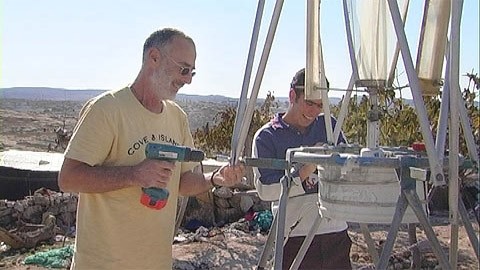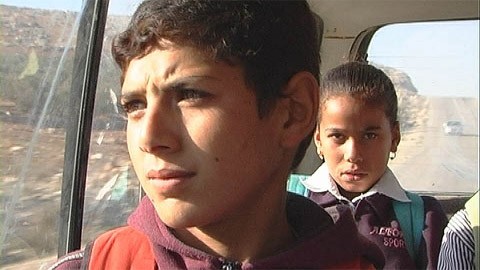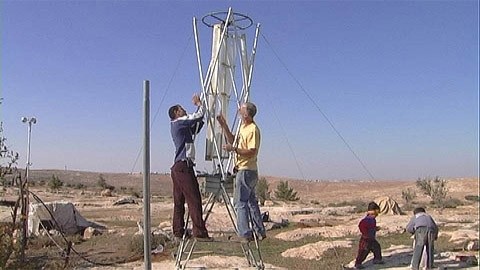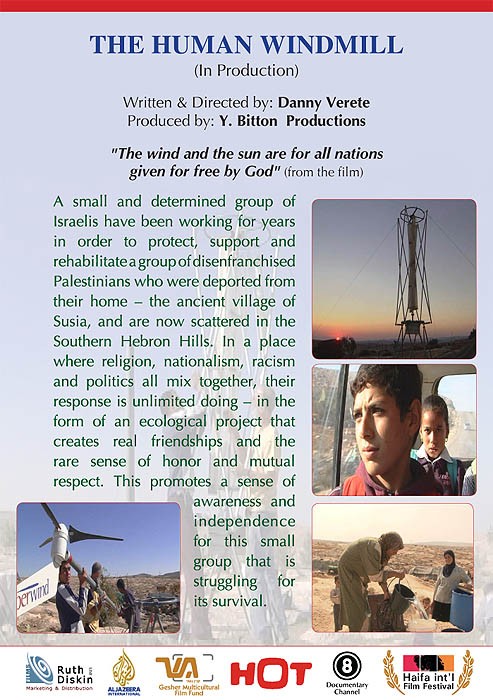In this beautiful film we follow the attempts to harness wind and solar energy for the benefit of the residents of the Palestinian village of Susia. And in the process we get to know extraordinary individuals from both sides of the conflict. What was missing in Noam Dotan’s otherwise perfect life? What made him- and others, leave symbols of success and devote themselves to a renewable energy project in a Palestinian village? What is this dream, shared with the residents of Susia, which is today coming to fruition? They work through action, rather than through protest or demonstrations. Three years in the making, in joint meetings with local residents, they have created a renewable energy project at Susia. They have succeeded in supplying electricity for residents living in tents and caves, figuratively and literally lighting up their lives.
Synopsis
In this beautiful film we follow the attempts to harness wind and solar energy for the benefit of the residents of the Palestinian village of Susia. And in the process we get to know extraordinary individuals from both sides of the conflict. What was missing in Noam Dotan’s otherwise perfect life? What made him- and others, leave symbols of success and devote themselves to a renewable energy project in a Palestinian village? What is this dream, shared with the residents of Susia, which is today coming to fruition? They work through action, rather than through protest or demonstrations. Three years in the making, in joint meetings with local...
Awards
- Best Middle length Documentary - Tranzyt International Film Festival, Poland, 2011
- Best Prize - 38th International Ekotopfilm Festival, Slovak Republic, 2011
- Special Mention - Pratt Foundation Awards, 2011
Festivals
- Palm Beach Jewish Film Festival, USA, 2013
- Zagreb Jewish Film Festival, Croatia, 2012
- 29th International Environmental Film Festival, Paris, 2012
- Transit International Documentary Film Festival, Poland, 2011
Press & Links:
This film is the beautiful story of the encounter between the Palestinians of this area with these Israelis. In addition to the help that is provided, they discover that the human encounter has been life-transforming for all involved. For the entire review by Amy Kronish, check: http://israelfilm.blogspot.com/2011/05/making-difference.html
Because of the Wind
Asher Kesher, Yediot HaDarom, Nov 2010
"We take electricity for granted" says Noam Dotan in one of the key scenes of the new documentary The Human Turbine. In Susia, one of the most remote points in the southern Hebron hills, the living conditions are such that the scattered population is not connected to any sort of civilization and certainly not to electricity or water. This is a traditional population that has inhabited the land since the late 19th century and whose lives have not changed that much since, especially in terms of their agricultural based livelihoods.
Recently, miraculously, a windmill and generators have appeared on the landscape along side the tin huts and canvass tents. These are enough to supply enough electricity to power an old TV set, to make a small refrigerator run and charge a cell phone. Those responsible for this are a group of "crazy people" – Israelis who have spent their weekends over the past two years helping this marginalized population.
The Human Turbine, a film by director Danny Verete and producer Yehuda Bitton is the story of the moving encounter between those Israeli academics and the nomads of Susia. All of the Israelis chose to give up their free time in order to channel their abilities into a renewable energy project. And one after another, the lights go on in the tents and caves – illuminating the possibility of a better life.
This film offers a slightly different look at the Israeli-Palestinian conflict on the one hand, and at the same time allows a peek at the timely topic of renewable energy. The Human Turbine won a prize at the Haifa International Film Festival this year.
Human, All too Human
Irena Melamed, Ynet, November 7, 2010
In his film "The Human Turbine" Danny Verete follows four Israelis who come to help Palestinians in the south Hebron hills and presents a moving human story about friendship between two peoples.
Normal People against the Separation Wall
Moran Sharir, Ha'aretz, Nov 7th, 2010
When Israeli television shows Arabs who are not members of Knesset, they tend to have only first names. Old people, dogs and children only have first names on Israeli TV. In "The Human Turbine" too the Palestinians only have first names – but so too the Israelis. There is no difference and there are not honorific titles. Everyone is the same. And they are all humans who happened into the same mess.
The film follows a group of Israelis who decide to devote their time to the Palestinian residents of Susia in the southern Hebron hills. They were expelled from their original village and since then have been living scattered in caves and tents and without any electricity or water. No one cares about them. Not the Israeli authorities and not the Palestinians. This film follows a group of people who do care. These are normal Israelis; Zionists and established people. Not radicals or anarchists against the Separation Wall.. They are more like "normal people against the Separation Wall" – and not only the physical wall, but also that psychological barrier that is so present in this region. Together with the local residents they build a turbine that creates electricity for the village. Maybe you can take away their land, their right to an education and even their human rights – but you cannot take the wind. The wind belongs to everyone.
Electricity Flows thru their Hands
Gili Iskovitch, Ha"aretz Nov 4, 2010
"The Human Turbine" is a warm and human film. A group of highly educated Israelis come together and decide to help the residents of the tiny Palestinian community of Susia. This village is basically a collection of shabby structures and caves where the people live in crowded situations without electricity or running water. Across from them, and adjacent to the ancient ruins of Susia, is the ever-growing Israeli settlement with its red roofs and swimming pool. This group of Israelis adopts the Palestinians of Susia and manages to connect them to both running water and electricity. They do this by harnessing the wind and sun. And even help them to get a milking facility going – thus changing the current reality ever so slightly.
This is a nice and optimistic story. And very human.
Jury's decision - The Human Turbine Award at the Haifa Film Festival, 2010:
The film provides a rare peek at a world in which humanity, compassion and cooperation provide hope for a different sort of life in the conflicted reality of the Middle East.Festivals
- Palm Beach Jewish Film Festival, USA, 2013
- Zagreb Jewish Film Festival, Croatia, 2012
- 29th International Environmental Film Festival, Paris, 2012
- Transit International Documentary Film Festival, Poland, 2011
- The Other Israel Film Festival, NY, 2011
- What Can Cinema Do International Film Festival, Paris, 2011
- Denver Jewish Film Festival, USA, 2012
- CMCA International Documentary and Current Affairs Film, Marseille, 2011
- Ischia International Film Festival, Italy 2011
- Sole Luna International Film Festival, Palermo, 2011
- Toronto Jewish Film Festival, Canada, 2011
- Sunnyvale Presbyterian Church, USA, 2011
- ISRATIM Film Festival, France, 2011
- FIPA-Biarritz International Film Festival, France, 2011
- Ecological Film Festival, Jerusalem, 2010
- Ecological Film Festival, Sdeh Boker, Israel, 2010
- Haifa International Film Festival - Official Competition, Israel, 2010
Educational
- Brandeis University
- Hebrew Univeristy
- University of Pennsylvania
- MESA Conference, 2011
- Duke University
- Harvard University
- Princeton University
- Willy Brandt Center, Jerusalem
Awards
- Best Middle length Documentary - Tranzyt International Film Festival, Poland, 2011
- Best Prize - 38th International Ekotopfilm Festival, Slovak Republic, 2011
- Special Mention - Pratt Foundation Awards, 2011
- Best Documentary awarded by The Other Israel Festival - Haifa Int'l Film Festival, 2010




